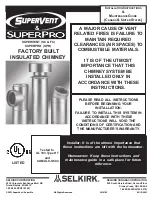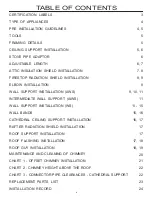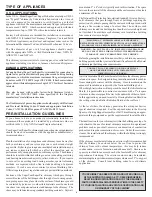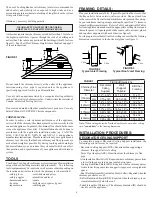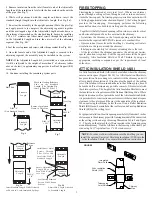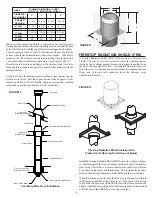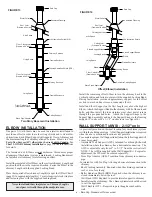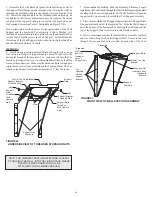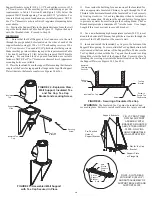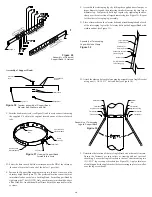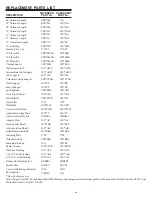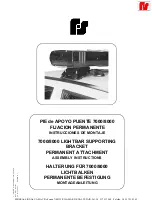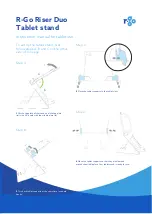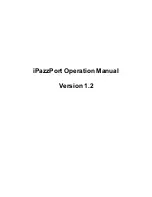
11
Use a non-hardening high-temperature silicone sealant (500°F) to seal
around the horizontal chimney length where it enters through the
exterior of the Wall Thimble or the concrete wall.
Twist lock a 12" section into the Female Coupler beneath the Support
Plate. Twist lock the Tee Plug into the bottom of the section. You can
substitute an Insulated Tee Plug (1TPI) for the 12" section.
Chimney Lengths above the Insulated Tee are simply stacked on and
locked with a 1/8 clockwise turn. It is highly recommended to secure all
exterior chimney joints with Locking Bands (SLB).
For lateral stability of the chimney above the Wall Support, a Wall Band
must be installed along an outside wall. Install the first Wall Band
midway up the first Chimney Length above the Insulated Tee. Any
additional Wall Bands are to be installed at 8 foot intervals above this
point.
The nut and bolt supplied will fasten the band around the chimney.
Wall Band
Figure 18
Securely fasten the Wall Band around the chimney with the supplied nut
and bolt. Check for clearances and plumb as you fasten the Wall Bands
to the wall. Use a level against the chimney section at each support stage
to keep the assembly plumb.
Secure the Wall Band bracket to the wall using two 6d (2”) spiral nails
or #8 x 2" wood screws or longer if required through the pre-drilled holes
(see Figure 18). For concrete or brick veneer walls use suitable masonry
fasteners.
ADJUSTABLE INTERMEDIATE
WALL SUPPORT (AIWS)
If the total chimney height exceeds the Wall Support (AWS) limitations
an Adjustable Intermediate Wall Support must be installed. Use of an
AIWS will support an additional 38ft. of chimney. The AIWS is
adjustable from 2" to 2-1/2" only from the vertical wall. Slide the
assembled Intermediate Wall Support over the protruding length of
chimney. Fasten the Intermediate Wall Support to the wall using four
1/4” by 2” wood screws through the pre-punched slots in each bracket.
Install the draw band around the protruding chimney length securely
against the support plate. Install four stainless steel sheet metal screws
firmly into the outer casing of the chimney, through the pre-punched
holes in the draw band. Cover the heads of the screws with a non-
hardening waterproof caulking.
NOTE: If a greater adjustment is required, such as to clear an overhang,
the WS Wall Support must be installed. This support is ordered
separately.
NOTE:
Interior chimneys installed with a Wall Support must use a
Firestop Radiation Shield (FRS) in place of Wall Bands if extending
through floor/ceiling penetrations and an Attic Insulation Shield when
passing through an unoccupied attic space.
If roof overhangs the wall of the structure so that passage of the
chimney is obstructed, it is necessary to cut an opening in the
overhang. Allow the minimum 2" air space clearance to combustible.
To find the exact spot where the chimney will pass through the
overhang, drop a plumb line from the underside to the outer edge of the
leveled chimney length. Mark 5 or 6 points to give an outline of the hole.
Keep in mind the 2" clearance to the chimney outer surface. Install an
Attic Insulation Shield if space permits on the under side of the
overhang. If it is not possible, the overhang can be enclosed and a
Rafter Radiation Shield installed at the roof level and a Finishing Plate
on the underside. If the Attic is open to the overhang, close off the
access with suitable building materials ensuring that a 2" air space
clearance is maintained. From above, install the Roof Flashing and
Storm Collar by following the Roof Flashing section in these instructions.
If the overhang is not deep enough to allow the chimney to be fully
installed within the overhang, it will be necessary to cut away a portion
of the overhang. Ensure that a 2" minimum air space clearance all
around the chimney is established.
Framing and flashing the sides of
the opening with suitable sheet metal will be required. Install a Wall
Band fastened securely to the wall structure directly beneath the
overhang. The installation of a Universal Roof Brace Kit may be
required if the chimney exceeds 5 feet or more above the roof.
WALL SUPPORT (WS) - Adjustable up to 6"
from a vertical wall (sold separately)
As previously mentioned, the ideal location for your chimney system
is within the building envelope. A Wall Support installation is required
when the above mentioned location is not possible.
To complete a proper Wall Support installation, the following parts will
or may be required:
- Wall Support (WS): Intended for a through-the-wall installation where
the chimney has a horizontal connection. The WS is adjustable from
2" to 6" from the vertical wall. NOTE: The WS is NOT supplied in the
Wall Support Kit.
- Stove Pipe Adaptor (ASE): Transition from chimney to flue pipe.
- Insulated Tee with Insulated Tee Cap: Allowing a horizontal connec-
tion to the chimney.
- Roof Flashing Assembly: Required when the chimney penetrates a
roof or a roof overhang.
- Rafter Radiation Shield (RRS): Required when the chimney is enclosed
immediately below the roof.
- Wall Band (WB); Universal Wall Band (UWB):Required to provide
lateral support to chimney.
- Suitable Lengths of Chimney: The chimney diameter should be sized
to suit the appliance.
- Chimney Length: Appropriate length for connection to Tee branch.
- Wall Thimble (WT): Required to pass though a combustible wall.
- Rain Cap: Standard or Deluxe model
The maximum chimney height above a Wall Support is indicated in Table
4 and illustrated in Figure19, all of which must be above the support.
The Wall Support will allow for an adjustment of 2" to 6" from a vertical
wall. Threaded studs are factory installed on both side brackets and
the support plate for fast and easy assembly (see
Figure 122).
Ensure the Wall Support Brackets are bolted securely to the wall .
The following steps will assist you in the installation of the Wall Thimble
and of the Wall Support. Figure 19 shows a typical Wall Support
installation through a combustible wall.
1. Determine the centre line of the horizontal connection (Chimney
Length through the wall) and frame an opening to the dimensions
specified for the Wall Thimble in a combustible wall. See Section A in
Table 3 and Figure 21 (A).
- Use a stud finder to roughly locate the walls studs. Mark the

